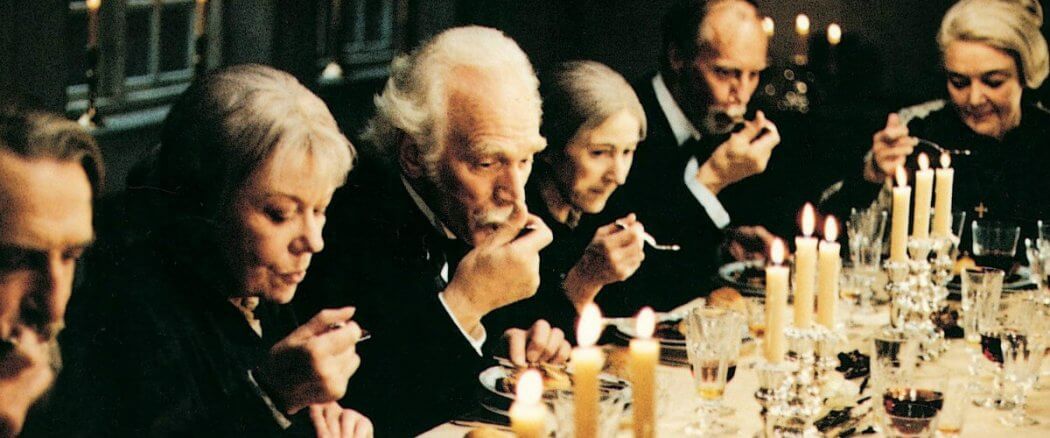Babette’s Feast is the 1987 masterpiece by Gabriel Axel. Masterpiece, in this case, is the warranted term. The film is beautiful. Not just the cinematography — the sparse landscapes, and constant grays and blues that create an intensely happy sort of melancholy — not just the acting, or the script, or any particular aspect. They all blend together so seamlessly that the movie doesn’t just stimulate and entertain us, but creates a soul stirring culmination. All like the feast for which the film is named.
In Denmark, during the 19th century, we observe life inside a small village, specifically the life of a small Lutheran congregation. In it we follow the daughters of the town’s pastor and admired leader — Martine and Philippa. They are young, beautiful, and gracious, so it is no wonder that two distinguished guests court them. A hussar staying with his aunt seeks the hand of Martine, and a famed Parisian singer, Philippa. Both suitors are rejected by the father, and the daughters grow up to become old maids.
Strangely, it is through these scorned lovers that true reconciliation comes to the town in the form of a meal.
Babette is sent to the sisters by Papin (the famed singer of Paris) in hopes that they can use the displaced housekeeper fleeing the aftermath of the French Revolution. She allows the sisters to serve their father’s flock despite its growing rifts and grudges. Then, as the old members of the church prepare to celebrate what would have been their pastor’s 100th birthday, Babette makes the request that she be allowed to prepare a special French meal in his honor and as gratitude to the two sisters.
The offer is accepted reluctantly, and with a great fear of what exactly they are in for. Yet, by the end of supper you witness an incredible providence, how small pains become great healers, and the power of reconciliation. All these people: begrudged, poor, rich, worldly, humble, proud, spiteful, loving — they all meet and kiss as mercy and truth.
Like the meal (a great work of art) this film has the same effect on us, the viewer. It can work within us to love our enemy and our neighbor.
Sensuality and Represssion
Throughout the film this battle of love is fought with an imbalance — similar to one the Church struggles with today. How do we balance our created sensual natures and the sins of the flesh?
Looking at church history we struggle to walk that fine line down the middle and tend to oscillate from one extreme reaction to the other. This is nothing new; Paul and Peter wrestle with this constantly in Acts. They have to answer questions about our freedom and our discipline to uphold a certain standard.
 In Babette’s Feast we see a great deal of repression and legalism, not just through the accusations of one congregant to another, but in the color of the film. The townspeople are all in drab attire. The homes are not just simple, but look cold and uninviting.
In Babette’s Feast we see a great deal of repression and legalism, not just through the accusations of one congregant to another, but in the color of the film. The townspeople are all in drab attire. The homes are not just simple, but look cold and uninviting.
These rules and the demeanor towards sins of the flesh does not, however, deter them. As the movie progresses nearer to the dinner we hear admonitions and accusations of affairs, cheating, stealing, and all sorts of things held in secret or resentment.
This begins to change with certain characters. Both the men who seek to marry Martine and Philippa have a different continence about them — their on-screen color pops, it stands out even though they are primarily the same colors as the rest of the town, but they are brighter, more lively. Babette is the same, and when General Lorens returns (formerly the hussar seeking Martine’s hand) to the dinner with his aunt his blue pops next to the funeral attire of the other guests.
The film drives at a need to balance these two extremes — sensuality and repression. Unbridled, sensuality consumes everything, burns it, and leaves us hollow (think of the gratuitous and dehumanizing sex scenes of Eyes Wide Shut, or the even more gut-wrenching 8MM).
Too much repression only sweeps under the rug what is always there, our sins. It does not allow grace to flourish, and for us to grow into something more. Like the dinner guests prior to their transformation, we would be stuck in a continual funeral service; a life of tears.
Legalism
Babette’s Feast does not deal in debauchery. There are hints to the knowledge of it, but we are primarily dealing in the stark world of legalistic living. What grows from that is not a better way of life. The townspeople do not grow into better disciples of Christ through strict sets of do this and not that. Instead they fall into continual quarrels over who holds the greater right. Not one looks to their own heart, but to the actions of someone else against them.
In many ways this is the political landscape we live in today. Turn on any news station’s running commentary and you will witness little more than finger pointing. Instead of seeking a path to reconciliation, they live off the feel goods exuded from self-righteousness. This is where the town is stuck, and legalism’s greater place than mercy is to blame.
The Sacramental
How do we transcend? Through the sacramental acts — these mysterious connecting points in which the sacred act of grace meets us in an elemental way. For the film this is through the act of creation, specifically an incredible meal, but it means to imply something more encompassing.
This is an incredible point to take away as a Christian living in a world where we are constantly consuming “art.” Think about the last time you have gone to a business where music is not being played, or a home where a television isn’t on. In many respects this is depressing and there is a counterculture pushing back against this. And in many respects I side with the push back, but it is also the ground for us to engage and transcend the world.
 Most art is not great. It is flawed, it sends convoluted messages, but it is all searching to comment on the way the world is. Most songs (most popular songs) are about love — usually finding it in the wrong places, or breaking up. Is it coincidental that Jesus used the image of marriage more than any other to depict his relationship to the church? Maybe Christians have some direction for the questions posed by the art of today.
Most art is not great. It is flawed, it sends convoluted messages, but it is all searching to comment on the way the world is. Most songs (most popular songs) are about love — usually finding it in the wrong places, or breaking up. Is it coincidental that Jesus used the image of marriage more than any other to depict his relationship to the church? Maybe Christians have some direction for the questions posed by the art of today.
Art can transcend our petty legalism, or indulge it. Art can drive at something deeper than a purely surface level sensuality. Babette’s feast could have simply been a technically well done French dinner, or it could have tasted superb; but it was more than both of these because it took on that need to create something great.
We can find these moments all around us, and when we do there is a richness to life that comes with that. It isn’t entirely happy, nor entirely sad. It’s this middle ground of God’s joy that we can begin to take on once we’ve shed ourselves of these other corruptions. The only problem is the moment, while here, is fleeting. It does not last… for now.
It is strange that so much of the essence within Babette’s Feast transcends the little town it takes place in. But, that is what great art does, and there is an incredible amount of this movie that we can incorporate into our day by day lives.
What Do We Do with the Film’s “Religiosity”?
Much has been said regarding the religious context and overtones of Babette’s Feast. Most of the Criterion Collection’s supplemental material (DVD extras and film essay) makes it very clear: This is not a religious movie.
Then what is Babette’s Feast?
If those closest to the story — even Karen Blixen — step wide from this interpretation what do we do with something that so obviously embodies Christian charity, true communion, and the place where mercy and truth have met?
Mark La Fanu, who penned the essay for Criterion, and several other commentators are quick to address the “religious” overtones of the film — they are just as quick to dismiss them as part of the culture, but not the essence of the truly human aspects that the film attempts to illuminate.
I see their point. There is something to the film that speaks to people outside the Christian faith. Something that moves them towards a greater understanding of truth and how we navigate and transcend our own shortcomings and circumstances; or how our personal sacrifices, although painful for a time, may be returned to us in a different and more complete way — if we are willing to humbly accept their loss and change and alteration, awaiting the day our loss is returned to us in greater form.
But isn’t that the Truth within Christianity? Doesn’t the Church posit that there is something greater that we strive for, that we touch at times on this earth, but cannot quite attain — our birthright as the image bearers of God? So, although I get the angle, I don’t think we can toss away the underlying source because we want it to be something universal. After all, what could be more universal than the one from whom all essence is breathed?
How Then Do We Live?
It is difficult to grasp the exact measure of this film. I’ve touched on aspects of it, but after watching this there seems to be so much to say, and at the same time so much not to. Instead of my words to close I will leave you with a clip from the good General Lorens Loewebhielm himself: Mercy and Truth Have Met Together.





